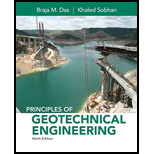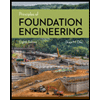
Find the modulus elasticity of the foundation soil with the various depth.
Answer to Problem 17.10P
The modulus elasticity of the foundation soil at the depth
The modulus elasticity of the foundation soil at the depth
The modulus elasticity of the foundation soil at the depth
The modulus elasticity of the foundation soil at the depth
The modulus elasticity of the foundation soil at the depth
The modulus elasticity of the foundation soil at the depth
Explanation of Solution
Given information:
The atmospheric pressure is
Assume the grain size
Show the depth and number of blows shown in table:
| Depth,(m) | |
| 1 | 6 |
| 2.5 | 8 |
| 4 | 11 |
| 5.5 | 13 |
| 7 | 14 |
| 8.5 | 16 |
Calculation:
Show the expression of correlation between
Here,
For c and a value given by Kulhawy and Mayne(1990).
Refer Table 17.7 in section 17.11 “Cone penetration test” in the textbook.
| c | a |
| 5.44 | 0.26 |
Find the variation of cone penetration resistance with various depth
Substitute
Find the variation of cone penetration resistance with various depth
Substitute
Find the variation of cone penetration resistance with various depth
Substitute
Find the variation of cone penetration resistance with various depth
Substitute
Find the variation of cone penetration resistance with various depth
Substitute
Find the variation of cone penetration resistance with various depth
Substitute
Show the expression of modulus elasticity
Here,
Find the modulus elasticity of the foundation soil at the depth
Substitute
Thus, the modulus elasticity of the foundation soil at the depth
Find the modulus elasticity of the foundation soil at the depth
Substitute
Thus, the modulus elasticity of the foundation soil at the depth
Find the modulus elasticity of the foundation soil at the depth
Substitute
Thus, the modulus elasticity of the foundation soil at the depth
Find the modulus elasticity of the foundation soil at the depth
Substitute
Thus, the modulus elasticity of the foundation soil at the depth
Find the modulus elasticity of the foundation soil at the depth
Substitute
Thus, the modulus elasticity of the foundation soil at the depth
Find the modulus elasticity of the foundation soil at the depth
Substitute
Thus, the modulus elasticity of the foundation soil at the depth
Want to see more full solutions like this?
Chapter 17 Solutions
Principles of Geotechnical Engineering (MindTap Course List)
- Exl: A footing is uniformly loaded with q = 100 kN/m² as shown in the figure. Compute the vertical stress increments under Points A, B, at z = 10 m. 13.5 m 7.0 m Footing 12 m (Plane view) 6.0 marrow_forwardA rectangular footing is uniformly loaded with q = 75 kN/m? as shown in the figure. Compute the vertical stress increments under Points A, B, and C at z = 5 m. 15 m 3.5 m A 1.87 m 8 m B Footing (Plane view)arrow_forwardThe square footing shown in the figure carries a load of 3500 kN. Assume that the stress below the footing is distributed at a slope of 1H:2V. The clay layer is overconsolidated with OCR=2. Pls answer asap. 3 decimal places.arrow_forward
- A rectangle pad footing with dimension bx1 = 2mx2m is subjected to axial loading N^tt = 600 kN. Foundation are constructed on ground surface shown as Figure 1. The water table is at -1.5m. The average unit weight of mass between soil and concrete above of the bottom foundation is given tb = 22 kN/m3. The results of the test of the relationship between the pressure and void ratio is shown in table. Load factor n is given n = 1.15.arrow_forwardFor the following statements: P: The lateral stress in the soil while being tested in an oedometer is always at-rest. Q: For a perfectly rigid strip footing at deeper depths in a sand deposit, the vertical normal contact stress at the footing edge is greater than that at its centre. R: The corrections for overburden pressure and dilatancy are not applied to measured SPT-N values in case of clay deposits. The correct combination of the statements is P Q R (a) True True False (b) False (c) False False True False False (d) True True Truearrow_forwardA square footing supporting a column applies a uniform pressure of 100 kPa on top of a deep clay deposit. Based on the bulbs of pressure developed below the footing shown in the following figure, which of the following statements are correct (select all that apply)? A.Immediately after construction, the effective vertical stress developed at Points B and C is the same. B.Immediately after construction, the excess pore water pressure (∆u) developed at Point B is lower than ∆u developed at Point A. C.After construction, the excess pore water pressure at Point C dissipates faster than that dissipated at Point B. D.arrow_forward
- A 3 ft square footing carries a sustained load of 10.6kips. It is placed on the surface of a 30 ft thick saturated overconsolidated clay underlain by dense sand. Based on laboratory tests, the clay can be adequately modeled using the e-log-p method. The laboratory tests provide the following compressibility information for the clay: y = 123.4lb/ft³ Cc = 0.064 1+eo Cr 1+eo Aom = 920lb/ft² The groundwater table is located at the ground surface. Estimate the primary consolidation occurred in the clay layer. Solution: Preliminary Calculations: 1). It should be adequate to compute the compressibility to a depth of = 0.0024 2). Layer thickness = ft; 2). Bearing pressure at the bottom of the footing: q = Primary consolidation for each layer: a). Layer 1: 1). depth to layer midpoint = 2). Total vertical stress at midpoint: Oz ft; 3). Pore water pressure at midpoint: u = 4). Effective vertical stress at minpoint: Oz! 6). Induced vertial stress: Az = = = 9). The type of this layer of soil is :…arrow_forwardA 2 m×4 m rectangular footing has to carry a uniformly distributed load of 120 kPa. As per the 2 :1 dispersion method of stress distribution, the increment in vertical stress (in kPa) at a depth of 2 m below the footing isarrow_forward11.19 Refer to Figure 11.45. A square footing, 2 x 2 m in size, supports a column load of 300 kN. The soil characteristics are given in the figure. Field monitoring indi- cated that the foundation settlement was 19 mm during the first 12 months. a. Estimate the average stress increase in the clay layer due to the applied load. b. Estimate the primary consolidation settlement. c. What is the degree of consolidation after 12 months? d. Estimate the coefficient of consolidation for the pressure range. e. Estimate the settlement in 24 months. 300 kN 1m 2m x 2 m Ya = 14 kN/m3 I m Yu = 17 kN/m 24% G, = 2.74 LL = 46 2 m o'= 40 kN/m² C, = 1/5C. Sand Clay Figure 11.45 O Cengrge learring 2014arrow_forward
- Question 3 a) In a geotechnical laboratory an oedometer test on a saturated clay soil was conducted. The results in the laboratory report stated that the Ce= 0.2, C, -0.04 and OCR = 4.5. The existing vertical effective stress in the field was 130 kPa. A shallow foundation was designed to construct above the soil condition. This will increase the vertical stress at the center of the clay by 50 kPa. The thickness of the clay layer is 2 m and its water content is 28%. Solve the primary consolidation settlement and determine the difference in the settlement if OCR value were 1.5 instead 4.5.arrow_forwardDetermine the effective stress increase, rate of increase of effective stress in the soil at depth of 4 meters below the footing. The water table is 5 meter below the footing. Soil below has the following properties in laboratory: wet mass=44g, dry mass=30.1g, wet volume=24.6cc, dry volume=15.9cc, SR=1.893, void ratio=1.3 (assume soil above WT is dry)arrow_forwardA square footing is loaded as shown in Figure 05.13. The center of the base of footing is at coordinate (0, 0, 0). Determine the increase in vertical stress at a point whose coordinate is (3, 0, 4) using pressure isobars based on Boussinesq equation for square footings shown in Figure 05.7. O O O 10.215 O 10.512 10.125 10.251 P = 900 KN #7 2 m Figure 05.13arrow_forward
 Principles of Geotechnical Engineering (MindTap C...Civil EngineeringISBN:9781305970939Author:Braja M. Das, Khaled SobhanPublisher:Cengage Learning
Principles of Geotechnical Engineering (MindTap C...Civil EngineeringISBN:9781305970939Author:Braja M. Das, Khaled SobhanPublisher:Cengage Learning Principles of Foundation Engineering (MindTap Cou...Civil EngineeringISBN:9781305081550Author:Braja M. DasPublisher:Cengage Learning
Principles of Foundation Engineering (MindTap Cou...Civil EngineeringISBN:9781305081550Author:Braja M. DasPublisher:Cengage Learning Principles of Foundation Engineering (MindTap Cou...Civil EngineeringISBN:9781337705028Author:Braja M. Das, Nagaratnam SivakuganPublisher:Cengage Learning
Principles of Foundation Engineering (MindTap Cou...Civil EngineeringISBN:9781337705028Author:Braja M. Das, Nagaratnam SivakuganPublisher:Cengage Learning


